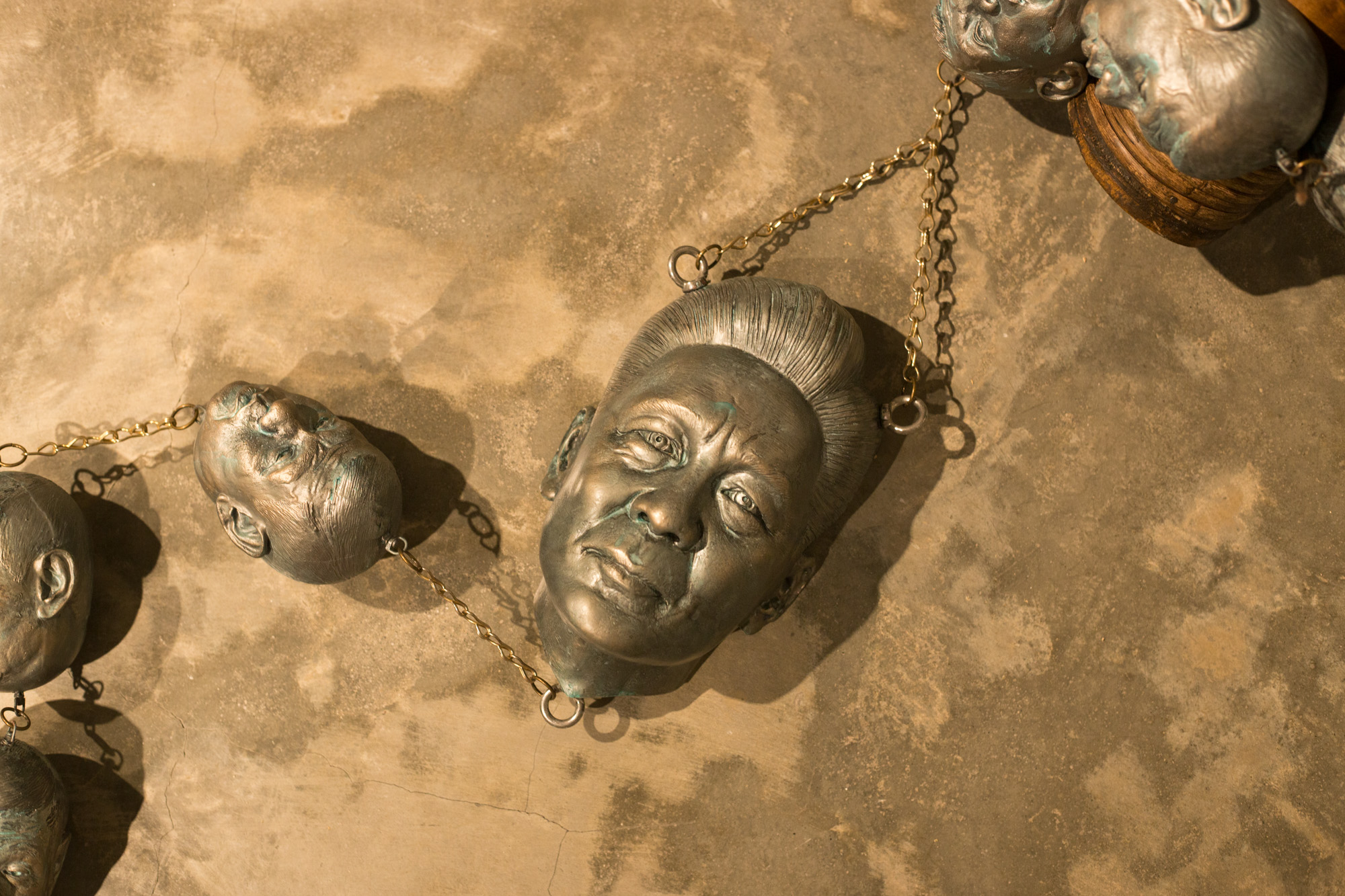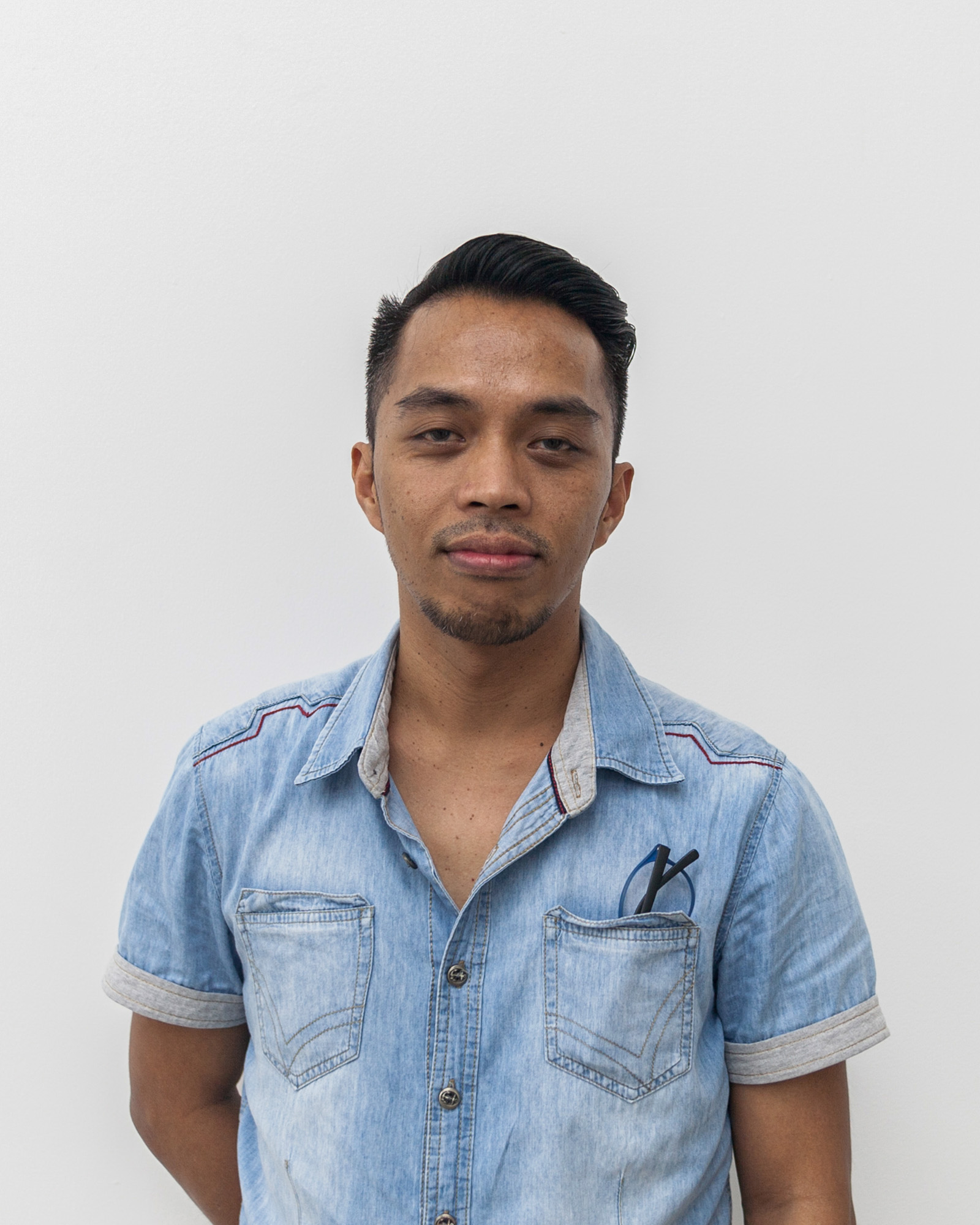Leslie de Chavez: Legacies of Dissent
By Portia Placino

LESLIE DE CHAVEZ, Latigo at Tinik Nang Bitukang Halang (detail), 2021, fiber-reinforced plastic, bamboo, brass, rattan, iron, and plaster, dimensions variable. Courtesy Silverlens, Manila.
“Considering the long history of these seemingly chronic conditions that we are in, it is of utmost importance that we create art that exemplifies sensitivity to the struggles, heartaches, aspiration, and dreams of our fellowmen.” Conversations like these with Leslie de Chavez are often enlightening. He navigates the art world through its institutions, markets, and communities by consistently keeping his responsibilities as an artist as a guiding point. His socially and politically charged works confront their audience—whether in the white cube of a gallery or out in the streets—even if the points of view he presents run against popular taste, particularly at this time of historical revisionism and the silencing of dissent.
De Chavez’s exhibition, “A Lonely Picket in the Balcony,” held in May at Silverlens gallery in Manila, reflected on his experiences of the pandemic while also bringing forward political aspects that many might shy away from. For instance, the installation Latigo at Tinik Nang Bitukang Halang (2021), several meters in length and partially propped against the wall, combines the form of a whip and a rosary, with the rosary beads replaced by the heads of populist presidents Rodrigo Duterte and Ferdinand Marcos, both known for their use of extrajudicial killings. He created the cross with resin forms of .38 caliber guns, a common weapon found in crime scenes tied to Duterte’s drug war. At the middle of the cross is a decaying fist made of plaster—the fist bump is a common symbol of support for Duterte—encapsulated in red-orange translucent resin. This piece shows De Chavez’s capacity to create something that could infuriate loud and confrontational supporters. Yet, the piece was quietly tucked away at Silverlens, provoking only those who cared to look closely.
De Chavez’s works are tied to a long tradition of dissent and activism by artists in the country against populist governments. The title of the exhibition, “A Lonely Picket in the Balcony,” references a protest at the opening of the Cultural Center of the Philippines (CCP) in 1969 during Ferdinand Marcos’s dictatorship. Artists David Medalla, Mars Galang, and Jun Lansang had unfurled banners stating: “We want a home not a fascist tomb!” “Abas la mystification. Down with Philistines!” and “Re:Gun/Go Home,” a pun on the name of then-California governor Ronald Reagan who attended the opening. The CCP was part of a grandiose cultural agenda of Imelda Marcos to create a narrative that kept the couple at the center of power. And though Ferdinand was eventually removed from office by the 1986 EDSA Revolution and fled into exile, the family has now found their way back to the Philippines and currently hold elected roles in government.

Portrait of LESLIE DE CHAVEZ. Courtesy Silverlens, Manila.
The key to the Marcos family’s return to power is the historical revisionism that has become rampant in recent years. The year 2016 was critical, with Duterte winning the presidency, and Ferdinand Marcos’ son Bongbong narrowly losing the vice-presidential contest, in a race during which they touted the Marcos era years as the country’s best time in postwar history. For the exhibition “Stirring the Ashes” at the Ateneo Art Gallery in 2016, De Chavez had responded to the onslaught of misinformation with the sculpture Palingenesis (2016), a large whip with metal chains and concrete heads in the form of Ferdinand Marcos. Yet while artworks such as Palingenesis challenged this revisionist perspective, the systematized manipulation in popular media drowned out such viewpoints. For De Chavez, creating artworks that may not translate so easily to the audience is still important as it continues to challenge those who might be open to it.
To create community-based conversations, De Chavez founded Project Space Pilipinas (PSP), initially in Mandaluyong, Metro Manila, in 2007, offering art residencies and exchanges with Southeast Asian artists and networks. But in 2012 he moved the initiative to Lucban, our mutual hometown, a few hours away from Manila in Quezon province. A small town with a cooler climate and more affordable living conditions, Lucban has a relaxed atmosphere and culturally engaged community, and proved to be the right site for a decentralized conversation on art. For the San Isidro Pahiyas Festival, celebrated every May 15, locals decorate their houses with kiping (rice wafers), rice, fresh fruits, and other produce. For local artists it is their moment to exhibit works and reach a wider audience.
The yearly celebration shows the creative predisposition of the community, and PSP activates it beyond this popular framing with projects such as the creation of the “SaLang” series in 2017, where they invite artists to exhibit for a month and engage the community with a particular theme. The guest artists created shows that dealt with territorial disputes, extra-judicial killings, dictatorships, climate change, and many other topics. Two years before Medalla passed away in 2020, PSP invited him and his partner, Adam Nankervis, to stage the participatory performance Signals in the Sky (2018), part of their series Mondrian Fan Club (1993–2020). In Lucban, they hung red, blue, and yellow canvases in an open field where performers stood while participants, mostly children, interacted by blowing and splattering paint.
De Chavez shared that when they give walkthroughs of PSP’s shows to locals—who range from students to the elderly—they encounter questions not only on the meaning of the artworks but inquiries on what are the artworks, given that there are rarely paintings on view. These candid conversations revealed the realities of a cultural discourse that is often confined to the white cube and academic institutions. But De Chavez shared that he is “confident that in the next decade or so, the local community will be even more responsive, engaging, and welcoming when confronted with emerging artistic tendencies, expressions, and art forms.”
PSP continues to enrich visual literacy, and expand the notions of creative and artistic practice. In 2020, they invited anyone interested to submit a one- minute video of their perspectives of the government lockdown for “Quarantined Lives.” The submissions ranged from everyday clips, socio-political commentaries, and Minecraft playthroughs. They released the videos on Facebook and Youtube and created a compilation with a surrealist story by Zeny Recidoro. They started 2021 with limited in-person exhibits such as “Hitherto I: To Ride a Jet Ski and Plant a Flag,” a play on Duterte’s 2016 campaign promise to ride a jet ski to the disputed territories in the West Philippine Sea and plant a flag himself. In line with the exhibit, they invited children for a drawing workshop to engage with the artworks presented.
The country is heading to a national election in 2022. Those who have declared their intention to run for key national positions are supporters of the current administration. Though protests in contemporary art such as in De Chavez’s works may be subtle and often placed silently in the institutions that allow them, continuing and enriching discourse is critical in moving forward. As De Chavez and I wrap up our conversation, we were both hopeful for possibilities in art and apprehensive about the future. De Chavez reflects, “It is crucial that we remind ourselves that we, as members of the cultural workforce, are responsible for the insightful shaping of our dynamic artistic traditions, its significance, and capabilities to empower our people and the community as a whole.”







